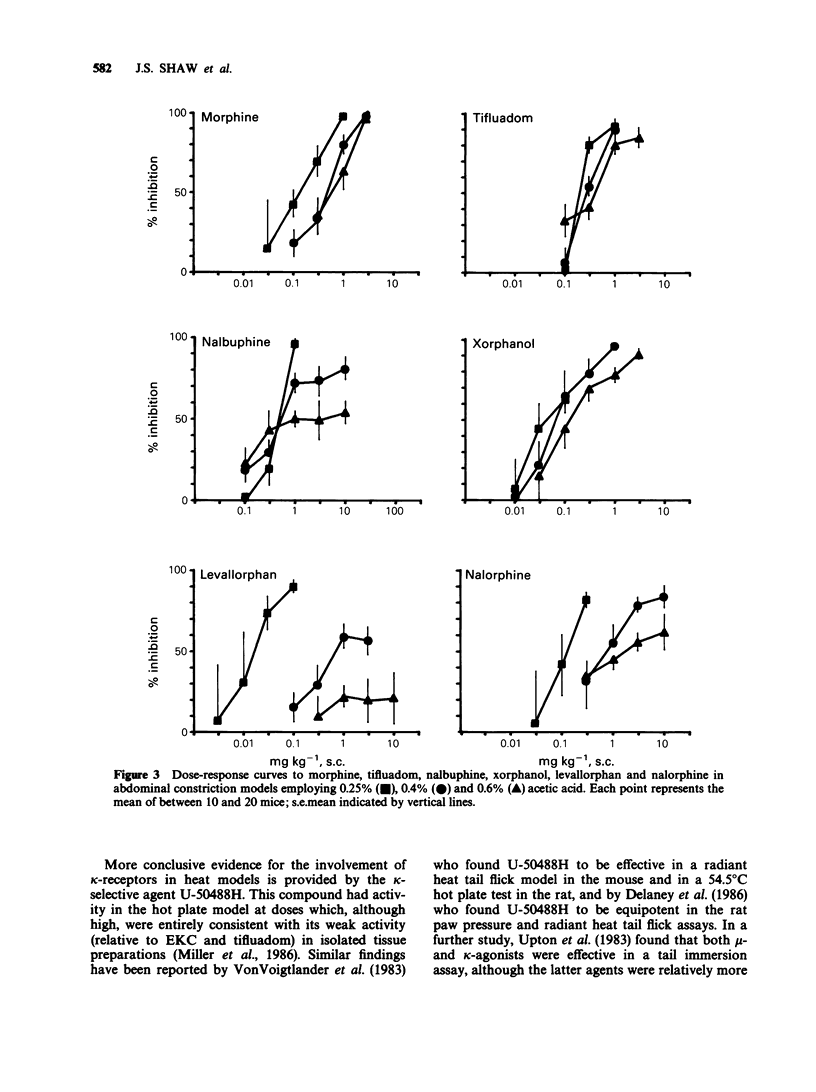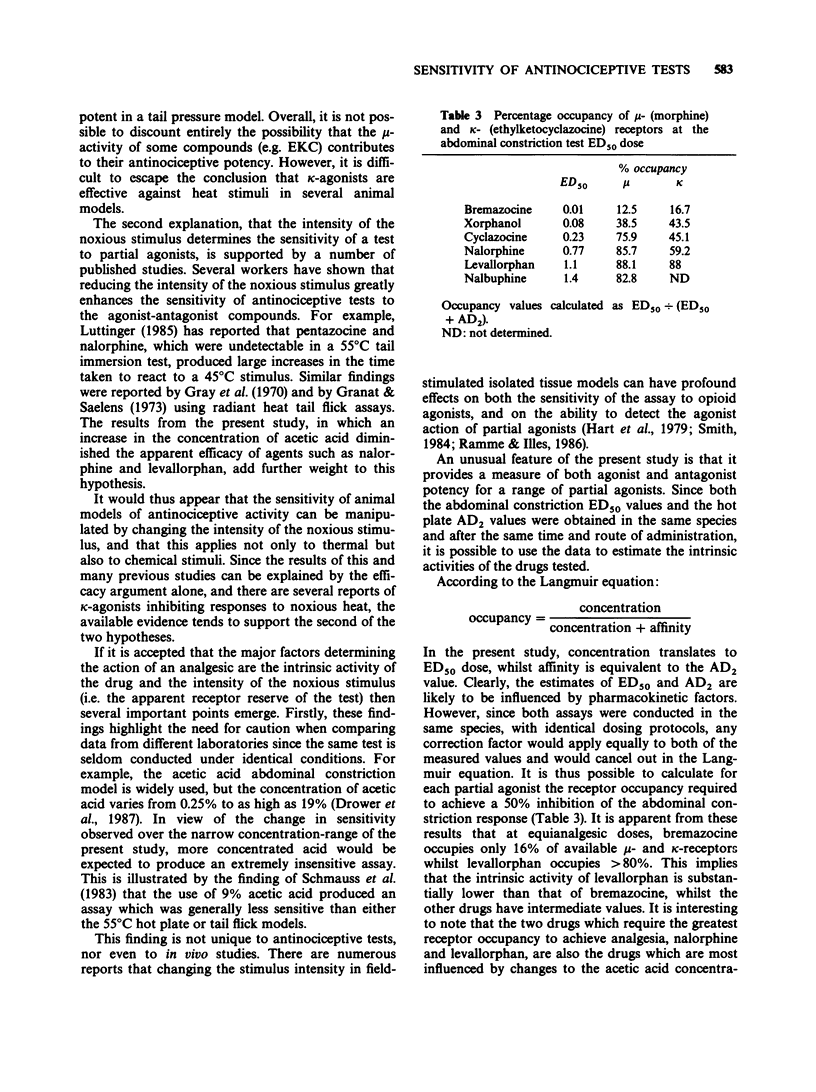Abstract
1. The antinociceptive activity of a range of opioid agonists and agonist-antagonist analgesics was determined in mice by use of the 55 degrees C hot plate and abdominal constriction assays. 2. Opioid agonists were approximately 10 times more effective in the abdominal constriction assay. 3. The agonist-antagonists produced analgesia only in the abdominal constriction assay, and antagonized the antinociceptive action of opioid agonists in the 55 degrees C hot plate test. 4. These differences were shown to be attributable to the different levels of stimulus employed in the two tests. 5. By comparing the antagonist potencies of the agonist-antagonists in the 55 degrees C hot plate test with their antinociceptive ED50 values in the abdominal constriction assay, an index of intrinsic activity was calculated.
Full text
PDF






Selected References
These references are in PubMed. This may not be the complete list of references from this article.
- Carroll J. A., Miller L., Shaw J. S., Downes C. P. Mu-receptor binding in physiological media: comparison with isolated tissue data. Neuropeptides. 1984 Dec;5(1-3):89–92. doi: 10.1016/0143-4179(84)90034-9. [DOI] [PubMed] [Google Scholar]
- Delaney K. M., Rourke J. D., Shaw J. S. Sensitivity of antinociceptive tests to opioid agonists and partial agonists. NIDA Res Monogr. 1986;75:438–441. [PubMed] [Google Scholar]
- Drower E. J., Stapelfeld A., Mueller R. A., Hammond D. L. The antinociceptive effects of prostaglandin antagonists in the rat. Eur J Pharmacol. 1987 Jan 20;133(3):249–256. doi: 10.1016/0014-2999(87)90020-3. [DOI] [PubMed] [Google Scholar]
- Granat F. R., Saelens J. K. Effect of stimulus intensity on the potency of some analgetic agents. Arch Int Pharmacodyn Ther. 1973 Sep;205(1):52–60. [PubMed] [Google Scholar]
- Gray W. D., Osterberg A. C., Scuto T. J. Measurement of the analgesic efficacy and potency of pentazocine by the D'Amour and Smith method. J Pharmacol Exp Ther. 1970 Mar;172(1):154–162. [PubMed] [Google Scholar]
- Hart S. L., Kitchen I., Waddell P. R. Different effects of current strength on inhibitory responses of the mouse vas deferens to methionine- and leucine-enkephalin. Br J Pharmacol. 1979 Jul;66(3):361–363. doi: 10.1111/j.1476-5381.1979.tb10838.x. [DOI] [PMC free article] [PubMed] [Google Scholar]
- Hayes A. G., Sheehan M. J., Tyers M. B. Determination of the receptor selectivity of opioid agonists in the guinea-pig ileum and mouse vas deferens by use of beta-funaltrexamine. Br J Pharmacol. 1985 Dec;86(4):899–904. doi: 10.1111/j.1476-5381.1985.tb11112.x. [DOI] [PMC free article] [PubMed] [Google Scholar]
- Kosterlitz H. W., Waterfield A. A. In vitro models in the study of structure-activity relationships of narcotic analgesics. Annu Rev Pharmacol. 1975;15:29–47. doi: 10.1146/annurev.pa.15.040175.000333. [DOI] [PubMed] [Google Scholar]
- Leander J. D. Evidence that nalorphine, butorphanol and oxilorphan are partial agonists at a kappa-opioid receptor. Eur J Pharmacol. 1983 Jan 21;86(3-4):467–470. doi: 10.1016/0014-2999(83)90198-x. [DOI] [PubMed] [Google Scholar]
- Leander J. D. Further study of kappa opioids on increased urination. J Pharmacol Exp Ther. 1983 Oct;227(1):35–41. [PubMed] [Google Scholar]
- Luttinger D. Determination of antinociceptive efficacy of drugs in mice using different water temperatures in a tail-immersion test. J Pharmacol Methods. 1985 Jul;13(4):351–357. doi: 10.1016/0160-5402(85)90017-8. [DOI] [PubMed] [Google Scholar]
- Martin W. R. Opioid antagonists. Pharmacol Rev. 1967 Dec;19(4):463–521. [PubMed] [Google Scholar]
- Miller L., Shaw J. S., Whiting E. M. The contribution of intrinsic activity to the action of opioids in vitro. Br J Pharmacol. 1986 Mar;87(3):595–601. doi: 10.1111/j.1476-5381.1986.tb10202.x. [DOI] [PMC free article] [PubMed] [Google Scholar]
- O'Callaghan J. P., Holtzman S. G. Quantification of the analgesic activity of narcotic antagonists by a modified hot-plate procedure. J Pharmacol Exp Ther. 1975 Mar;192(3):497–505. [PubMed] [Google Scholar]
- Ramme D., Illes P. Differential effect of stimulation strength in mouse vas deferens on inhibition of neuroeffector transmission by receptor type selective opioids. Naunyn Schmiedebergs Arch Pharmacol. 1986 Jan;332(1):57–61. doi: 10.1007/BF00633197. [DOI] [PubMed] [Google Scholar]
- Schmauss C., Yaksh T. L., Shimohigashi Y., Harty G., Jensen T., Rodbard D. Differential association of spinal mu, delta and kappa opioid receptors with cutaneous thermal and visceral chemical nociceptive stimuli in the rat. Life Sci. 1983;33 (Suppl 1):653–656. doi: 10.1016/0024-3205(83)90587-8. [DOI] [PubMed] [Google Scholar]
- Sewell R. D., Spencer P. S. Antinociceptive activitiy of narcotic agonist and partial agonist analgesics and other agents in the tail-immersion test in mice and rats. Neuropharmacology. 1976 Nov;15(11):683–688. doi: 10.1016/0028-3908(76)90037-x. [DOI] [PubMed] [Google Scholar]
- Smith C. F. Morphine, but not diacetyl morphine (heroin), possess opiate antagonist activity in the mouse vas deferens. Neuropeptides. 1984 Dec;5(1-3):173–176. doi: 10.1016/0143-4179(84)90055-6. [DOI] [PubMed] [Google Scholar]
- Smits S. E., Takemori A. E. Quantitative studies on the antagonism by naloxone of some narcotic and narcotic-antagonist analgesics. Br J Pharmacol. 1970 Jul;39(3):627–638. doi: 10.1111/j.1476-5381.1970.tb10370.x. [DOI] [PMC free article] [PubMed] [Google Scholar]
- TABER R. I., GREENHOUSE D. D., IRWIN S. INHIBITION OF PHENYLQUINONE-INDUCED WRITHING BY NARCOTIC ANTAGONISTS. Nature. 1964 Oct 10;204:189–190. doi: 10.1038/204189a0. [DOI] [PubMed] [Google Scholar]
- Tyers M. B. A classification of opiate receptors that mediate antinociception in animals. Br J Pharmacol. 1980 Jul;69(3):503–512. doi: 10.1111/j.1476-5381.1980.tb07041.x. [DOI] [PMC free article] [PubMed] [Google Scholar]
- Tyers M. B. Studies on the antinociceptive activities of mixtures of mu- and kappa-opiate receptor agonists and antagonists. Life Sci. 1982 Sep 20;31(12-13):1233–1236. doi: 10.1016/0024-3205(82)90350-2. [DOI] [PubMed] [Google Scholar]
- Upton N., Sewell R. D., Spencer P. S. Analgesic actions of mu- and kappa-opiate agonists in rats. Arch Int Pharmacodyn Ther. 1983 Apr;262(2):199–207. [PubMed] [Google Scholar]
- Vonvoigtlander P. F., Lahti R. A., Ludens J. H. U-50,488: a selective and structurally novel non-Mu (kappa) opioid agonist. J Pharmacol Exp Ther. 1983 Jan;224(1):7–12. [PubMed] [Google Scholar]
- Ward S. J., Takemori A. E. Relative involvement of mu, kappa and delta receptor mechanisms in opiate-mediated antinociception in mice. J Pharmacol Exp Ther. 1983 Mar;224(3):525–530. [PubMed] [Google Scholar]


